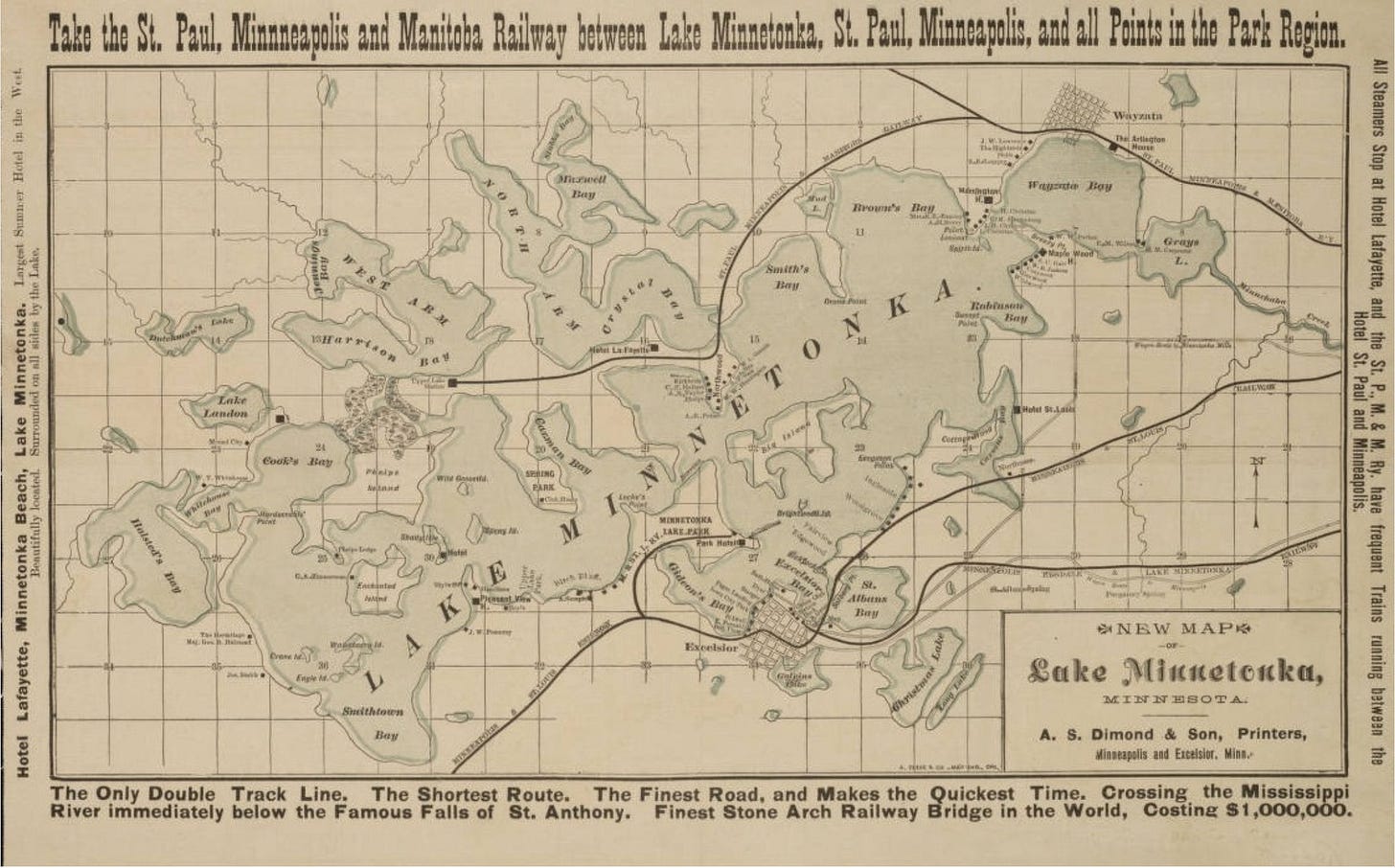The Lafayette Club on Lake Minnetonka (and Pillsbury A-Mill)
Not the only interesting buildings in Minnesota
It’s July 4 weekend, 2025, so lots of Minnesotans are heading for water, which historians(?) tell us we have a lot of because of ice age glaciers carving the land… probably we should just take their word for it, right?
On this note, have lately come to noticing some interesting buildings and architectural design that used to or still exists around Minnesota.
Today, because of the lake theme, we’ll start with an historic hotel overlooking water. Some of you may know about Lake Minnetonka or even have been on it. But you probably never stayed in a hotel like this.
This post is taking us back about 145 years…
Watercolor by Mary Ostazeski-Johnson showing the 300’ steamship The Belle of Minnetonka which apparently could seat 2,500 passengers, in the foreground, with the train arriving at the Hotel LaFayette, where all 300 rooms had a lake view.
How did this ‘steamship’ sit so high in the water?, one may wonder.
And why haven’t I heard of this remarkable hotel?
Here’s a nice tumblr post where some of these photos are taken…
https://www.tumblr.com/hclib/145268434076/lafayette-hotel-1880s-lake-minnetonka-vacation
The LaFayette is nestled between Crystal and Lafayette Bays, central on this 1901 map.
A page it seems from a hotel brochure, celebrating July 4 1893.
And other advertisement for the trains and ships that brought people from all across the land.
Look at that detailed advertisement of Lake Minnetonka… the intricate railways, one of which runs right to the front door of Hotel LaFayette.
Also from the Tumblr post:
From the Tumblr:
By the 1890s, business on the lake began to slow down. The Panic of 1893 had hit tourism hard, but interest in newer destinations in the West and better control of yellow fever also played a role. On October 4, 1897, a fire broke out at the back of the hotel after it had closed for the season. The entire structure was ablaze within minutes and was declared a total loss. The Minneapolis Tribune offered a brief eulogy:
"The famous hostelry, which has been the scene of so much gaiety and pleasurable entertainment, and has sheltered under its roof the aristocracy and wealth of the continent, will henceforth be referred to as of the past, and remembered only for the pleasures which are forever gone."
Sure were a lot of fires in the late 1800s. Why do fires happen to the most interesting buildings? Here’s a recent post suspiciously emphasizing the fire-proofness of the new construction.
Many people think those spheres high above the rooftops are just the tops of flagpoles.
And why are the skies always white in these old photos?
In this photo above, even the spires themselves are whited out.
In the next few posts we’ll turn to Minneapolis itself, which has many interesting buildings from the 1800s, including several which records are quiet about how exactly they were built.
That’s a view of Minneapolis from the east side of the Mississippi, the Stone Arch Bridge (which the Minnetonka Map previously called “The Finest Stone Arch Bridge in the World”) just visible on the right, the train on the west side, and the clock tower of Minneapolis City Hall (The Municipal Building) center in the background. There’s a lot going on in this picture, which we’ll get to!
But maybe next week we will start with this building, where I lived (more recently) but which dates back to the 1880s. They loved their spires in the late 1800s.
Skies to left and right of building are quite discolored so I am curious about the add-ons to the mill and when those were constructed… will look into before the next post.
Will leave you with this…
The Pillsbury A-Mill, in 2011, was included on the National Trust for Historic Preservation’s list of 11 Most Endangered Places.
So you and I know there’s more to discover.
As I said, lived there 5 years from re-opening (as residences) in 2016 until 2020… so maybe I noticed a few things, but who knows if I can remember :)












I love that you’re doing this. So much of history has been wiped. I’d be curious to see the who owned the property on Tonka after the fire, and who owns it now. I’ll look into that and post here.